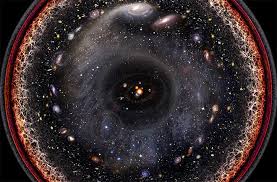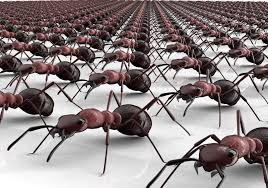Complex Physical and Adaptive Systems
Posted by Hindol Datta
There are two models in complexity. Complex Physical Systems and Complex Adaptive Systems! For us to grasp the patterns that are evolving, and much of it seemingly out of our control – it is important to understand both these models. One could argue that these models are mutually exclusive. While the existing body of literature might be inclined toward supporting that argument, we also find some degree of overlap that makes our understanding of complexity unstable. And instability is not to be construed as a bad thing! We might operate in a deterministic framework, and often, we might operate in the realms of a gradient understanding of volatility associated with outcomes. Keeping this in mind would be helpful as we deep dive into the two models. What we hope is that our understanding of these models would raise questions and establish mental frameworks for intentional choices that we are led to make by the system or make to influence the evolution of the system.
Complex Physical Systems (CPS)
Complex Physical Systems are bounded by certain laws. If there are initial conditions or elements in the system, there is a degree of predictability and determinism associated with the behavior of the elements governing the overarching laws of the system. Despite the tautological nature of the term (Complexity Physical System) which suggests a physical boundary, the late 1900’s surfaced some nuances to this model. In other words, if there is a slight and an arbitrary variation in the initial conditions, the outcome could be significantly different from expectations. The assumption of determinism is put to the sword. The notion that behaviors will follow established trajectories if rules are established and the laws are defined have been put to test. These discoveries by introspection offers an insight into the developmental block of complex physical systems and how a better understanding of it will enable us to acknowledge such systems when we see it and thereafter allow us to establish certain toll-gates and actions to navigate, to the extent possible, to narrow the region of uncertainty around outcomes.

The universe is designed as a complex physical system. Just imagine! Let this sink in a bit. A complex physical system might be regarded relatively simpler than a complex adaptive system. And with that in mind, once again …the universe is a complex physical system. We are awed by the vastness and scale of the universe, we regard the skies with an illustrious reverence and we wonder and ruminate on what lies beyond the frontiers of a universe, if anything. Really, there is nothing bigger than the universe in the physical realm and yet we regard it as a simple system. A “Simple” Complex Physical System. In fact, the behavior of ants that lead to the sustainability of an ant colony, is significantly more complex: and we mean by orders of magnitude.

Complexity behavior in nature reflects the tendency of large systems with many components to evolve into a poised “critical” state where minor disturbances or arbitrary changes in initial conditions can create a seemingly catastrophic impact on the overall system such that system changes significantly. And that happens not by some invisible hand or some uber design. What is fundamental to understanding complex systems is to understand that complexity is defined as the variability of the system. Depending on our lens, the scale of variability could change and that might lead to different apparatus that might be required to understand the system. Thus, determinism is not the measure: Stephen Jay Gould has argued that it is virtually impossible to predict the future. We have hindsight explanatory powers but not predictable powers. Hence, systems that start from the initial state over time might represent an outcome that is distinguishable in form and content from the original state. We see complex physical systems all around us. Snowflakes, patterns on coastlines, waves crashing on a beach, rain, etc.
Complex Adaptive Systems (CAS)
Complex adaptive systems, on the contrary, are learning systems that evolve. They are composed of elements which are called agents that interact with one another and adapt in response to the interactions.

Markets are a good example of complex adaptive systems at work.
CAS agents have three levels of activity. As described by Johnson in Complexity Theory: A Short Introduction – the three levels of activity are:
- Performance (moment by moment capabilities): This establishes the locus of all behavioral elements that signify the agent at a given point of time and thereafter establishes triggers or responses. For example, if an object is approaching and the response of the agent is to run, that would constitute a performance if-then outcome. Alternatively, it could be signals driven – namely, an ant emits a certain scent when it finds food: other ants will catch on that trail and act, en masse, to follow the trail. Thus, an agent or an actor in an adaptive system has detectors which allows them to capture signals from the environment for internal processing and it also has the effectors that translate the processing to higher order signals that influence other agents to behave in certain ways in the environment. The signal is the scent that creates these interactions and thus the rubric of a complex adaptive system.
- Credit assignment (rating the usefulness of available capabilities): When the agent gathers experience over time, the agent will start to rely heavily on certain rules or heuristics that they have found useful. It is also typical that these rules may not be the best rules, but it could be rules that are a result of first discovery and thus these rules stay. Agents would rank these rules in some sequential order and perhaps in an ordinal ranking to determine what is the best rule to fall back on under certain situations. This is the crux of decision making. However, there are also times when it is difficult to assign a rank to a rule especially if an action is setting or laying the groundwork for a future course of other actions. A spider weaving a web might be regarded as an example of an agent expending energy with the hope that she will get some food. This is a stage setting assignment that agents have to undergo as well. One of the common models used to describe this best is called the bucket-brigade algorithm which essentially states that the strength of the rule depends on the success of the overall system and the agents that constitute it. In other words, all the predecessors and successors need to be aware of only the strengths of the previous and following agent and that is done by some sort of number assignment that becomes stronger from the beginning of the origin of the system to the end of the system. If there is a final valuable end-product, then the pathway of the rules reflect success. Once again, it is conceivable that this might not be the optimal pathway but a satisficing pathway to result in a better system.
- Rule discovery (generating new capabilities): Performance and credit assignment in agent behavior suggest that the agents are governed by a certain bias. If the agents have been successful following certain rules, they would be inclined toward following those rules all the time. As noted, rules might not be optimal but satisficing. Is improvement a matter of just incremental changes to the process? We do see major leaps in improvement … so how and why does this happen? In other words, someone in the process have decided to take a different rule despite their experiences. It could have been an accident or very intentional.
One of the theories that have been presented is that of building blocks. CAS innovation is a result of reconfiguring the various components in new ways. One quips that if energy is neither created, nor destroyed …then everything that exists today or will exist tomorrow is nothing but a reconfiguration of energy in new ways. All of tomorrow resides in today … just patiently waiting to be discovered. Agents create hypotheses and experiment in the petri dish by reconfiguring their experiences and other agent’s experiences to formulate hypotheses and the runway for discovery. In other words, there is a collaboration element that comes into play where the interaction of the various agents and their assignment as a group to a rule also sets the stepping stone for potential leaps in innovation.
Another key characteristic of CAS is that the elements are constituted in a hierarchical order. Combinations of agents at a lower level result in a set of agents higher up and so on and so forth. Thus, agents in higher hierarchical orders take on some of the properties of the lower orders but it also includes the interaction rules that distinguishes the higher order from the lower order.
Posted on December 8, 2018, in Business Process, Chaos, Complexity, Innovation, Learning Organization, Learning Process, Model Thinking, Order, Organization Architecture, Social Dynamics and tagged adaptive, CAS, Complexity, CPS, creativity, economics, innovation, open source, platform, Systems Thinking, transparency, uncertainty. Bookmark the permalink. Comments Off on Complex Physical and Adaptive Systems.
Comments are closed.